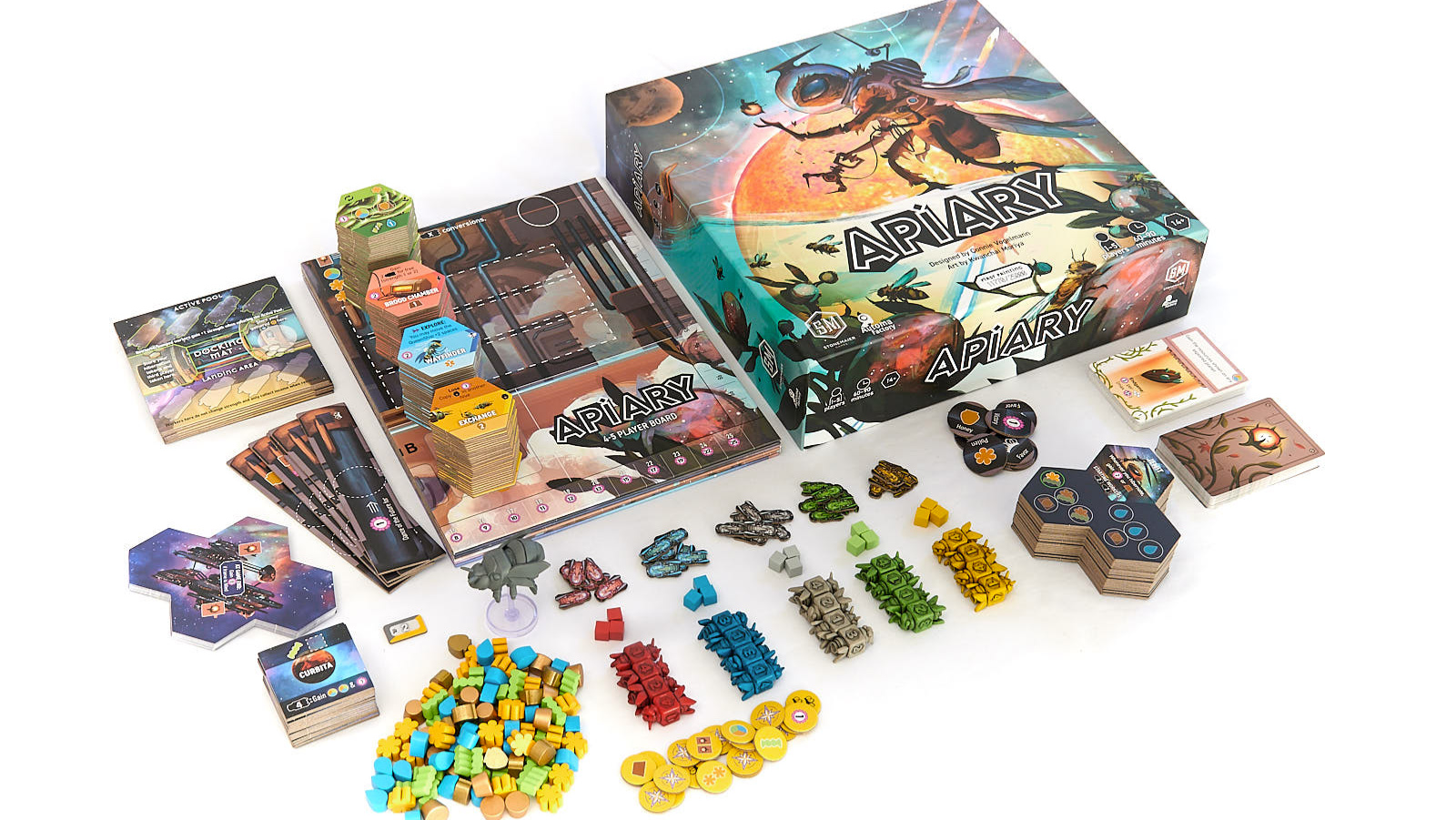
Earlier this month, Stonemaier Games announced their next game release, a totally new property by first-time designer Connie Vogelmann: Apiary. A 1-5 player competitive worker-placement game about spacefaring bees from the future? To say that the tabletop community was abuzz about it would be an understatement (and a not-so-clever pun). We got a chance to ask Connie about the game, her influences, and a few other things:
Apiary is your first commercial game release, I believe? What led you to designing a board game?
I fell into it! I started playing modern euro games around 2010 or 2011, and dove into the hobby headfirst. By the time Apiary came around (in early 2019), I had been playing board games for almost a decade, and was starting to really learn how to analyze and evaluate the games I played. It was common for my partner David and I to spend time discussing each game we played, including evaluating which mechanisms appealed more or less to each of us, and why.
In 2018, David had an idea for a board game, and I offered to help in a support capacity – I volunteered to make prototype components, help run playtests, and so forth. That endeavor ended up being pretty short lived, and we learned 3 things: (1) David doesn’t especially like game design; (2) I completely love it, and (3) we absolutely cannot design games together. David prefers a methodical approach, whereas I like to throw a million things at the wall and see what sticks.
That experience was critical for two reasons: first, it gave me the design bug. This was a completely new facet of board games for me, and one that I found to be incredibly mentally engaging and satisfying. Second, during one of those early playtests, we met Elizabeth Hargrave, who connected us with the local DC game design community, which has been an excellent resource and support network ever since.
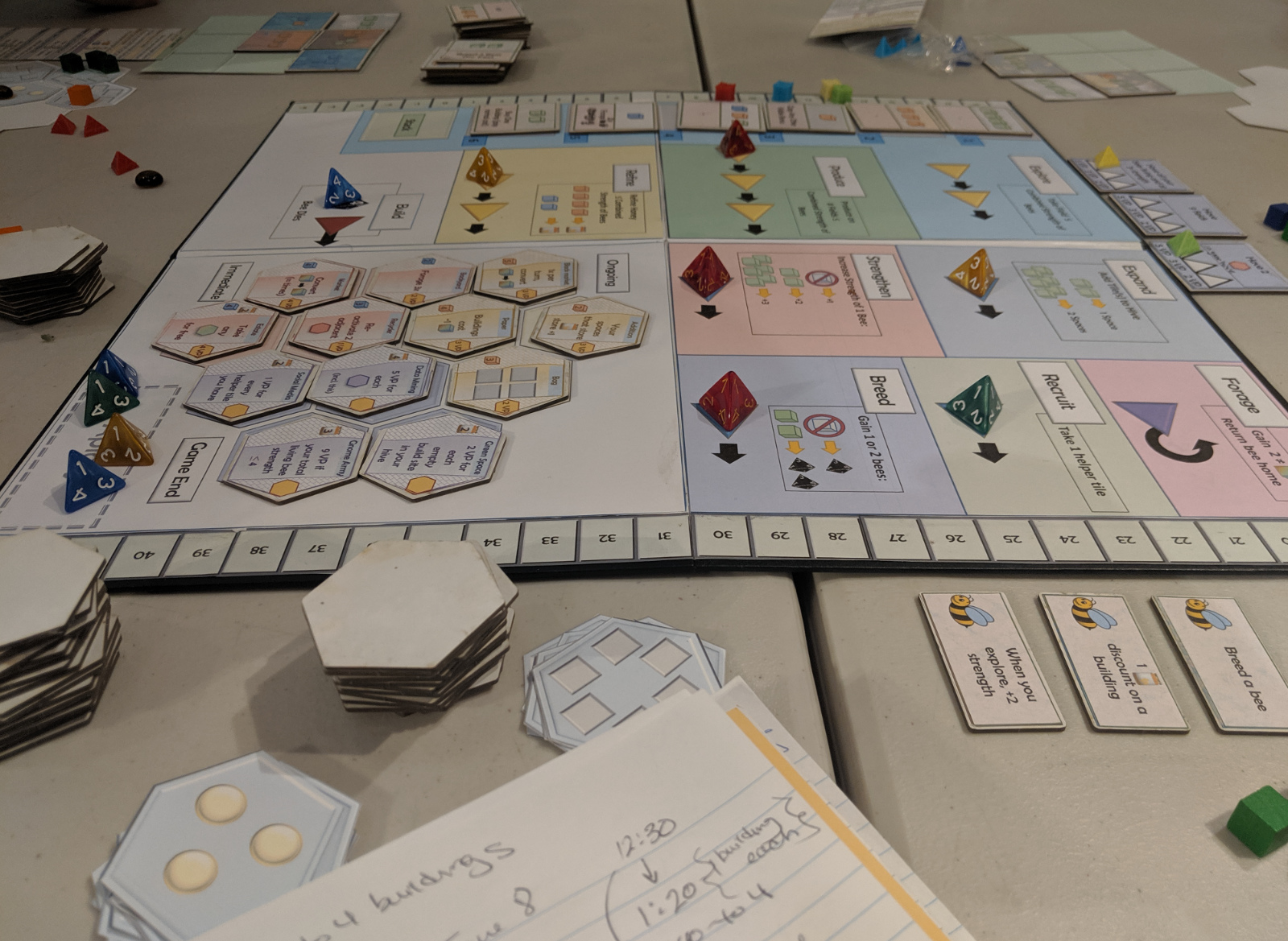
Apiary prototype from June 2019
What inspired you to make a game about bees, and how did the sci-fi aspect come into it?
My grandfather was a lifelong beekeeper, and I have fond memories of spinning the honey extractor and “helping” him as a kid. Around the same time I started working on Apiary, I was gearing up to keep bees myself, so bees and beekeeping were at the forefront of my mind.
This idea for Apiary came about during a conversation with some friends, in which we were discussing shortcomings associated with “traditional” worker placement games. In a lot of worker placement games, one of the options available to players is “gain another worker.” This is typically expensive to do, and requires significant upfront investment for a delayed payoff. In practical terms, this means that the interesting decision space – where deciding whether to get a new worker is a crunchy decision – is relatively small.
The core concept for Apiary came out of that conversation, and is based on the question: “what if your workers aged and died?” With this change, players become responsible for managing a dynamic pool of workers, which creates interesting decisions from the beginning to the end of a game. The honeybee theme clicked almost instantaneously with this core concept: in a beehive, each worker doesn’t live very long, so new workers are constantly being added to the pool (and old workers are leaving it). The game had a honeybee theme from its very inception, and much of the game is modeled around that theme.
The move to space happened quite a bit later. I attended Stonemaier’s Design Day in 2021 and brought Apiary. After the event, I discussed the game with Jamey Stegmaier – he was potentially intrigued by the game (it had received good feedback at Design Day!), but he was worried about the theme. Honey Buzz had just come out to excellent reviews, and Jamey was concerned by the fact that Apiary shared a similar theme, weight, and core mechanism (worker placement). He asked me if I would be willing to move the game to outer space, with a futuristic, science-fiction theme. I immediately agreed! I am a huge science fiction fan, and adding a science fiction twist actually solved several design problems associated with the game. Specifically – why were bees recruiting friends from other hives to help them out? And why were the bees adding powerful technologies to their hives? So I dove head-first into the (partial) re-theme, which really ended up helping the game shine. Plus, with the move to space, we could have the workers hibernate instead of die, which makes the whole game a little bit more cheerful.
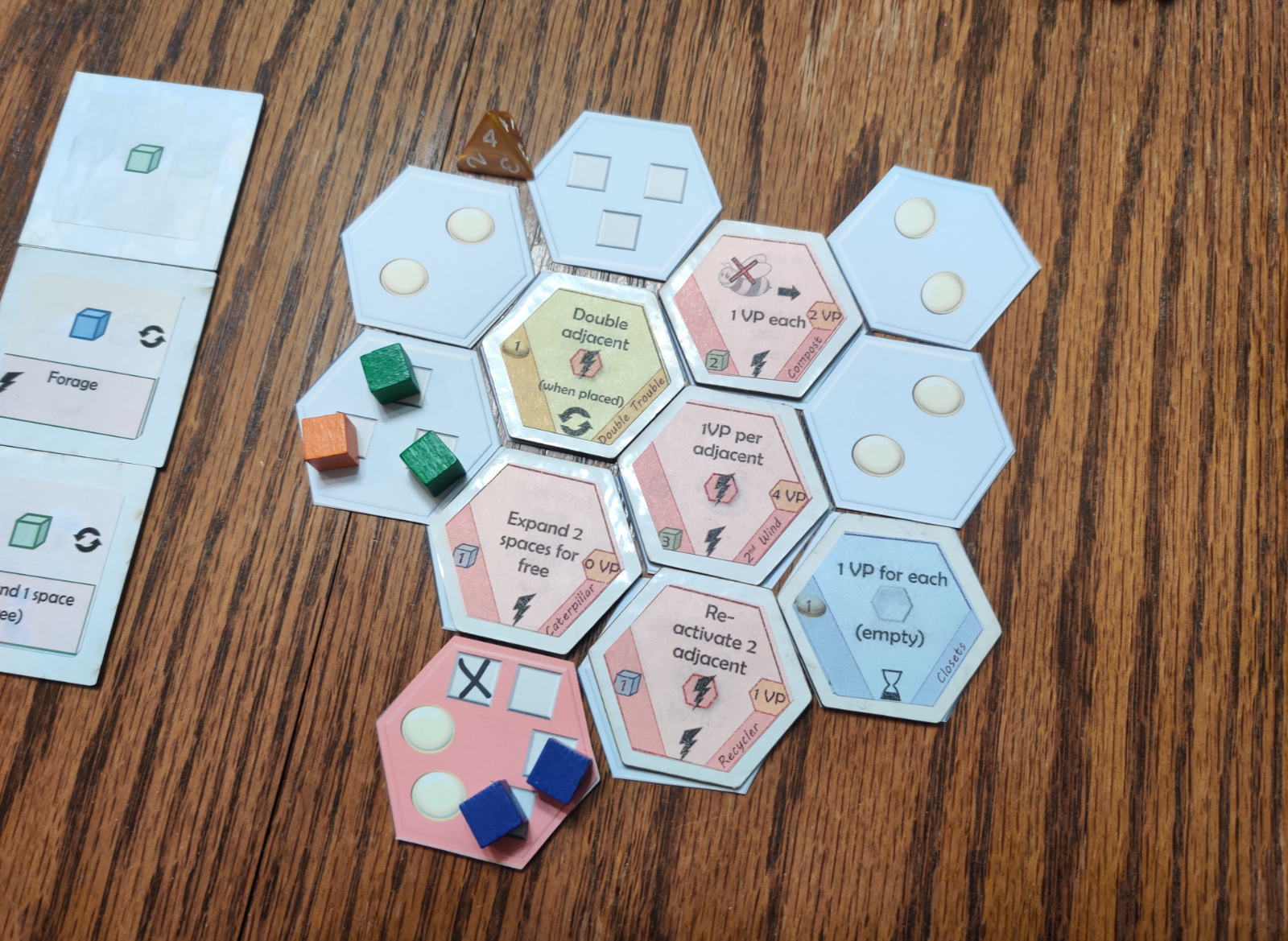
Prototype- February 2020
Mechanically, what kind of game is Apiary? What do you feel makes it stand out from games with similar mechanics (besides theme)?
Apiary is a worker placement, tableau building game that is centered around creating fun combos and “breaking the rules” of the game. I think there are several parts of the game that stand out in terms of gameplay:
First, as I touched upon above, the core concept behind Apiary is the idea that your workers age and ultimately leave your worker pool. Most new workers start out at a strength 1, then level up automatically each time you use them. After a worker would age “beyond” strength 4, it must hibernate, and leaves your pool. This means that you – as the player – always have a slightly different pool of workers.
Closely related to the aging is the dynamism associated with your actions: each action that you do in the game depends on the strength of the worker that you place on a space, and may also depend on the strength of the workers that are already present at that location. The higher the total strength is at a given action space, the more powerful an action you can take.
At the same time, however, worker placement spaces are never blocked. Sometimes when you go to a space where there is already a worker, you “bump” that worker back to its owner. This creates a crunchy sequencing puzzle – not only do you have to manage your ever-changing worker pool, but you also have to sequence your actions correctly to take into account the strength of your own workers, the workers that are already on the board, and manage bumping other players (and being bumped by them!).
Finally, while Apiary has engine building elements, a core aspect of the game is putting together fun combos that otherwise break fundamental rules of the game. In Apiary, there is a bonus associated with each action space, that can typically only be unlocked by placing a strength 4 worker on that space. A big part of the game is figuring out how to “cheat” by finding ways to activate those bonuses additional times. Because the setup of the game is so variable (there are 20 factions, 5 different hive mats, and dozens of tiles and cards), each game feels very different, and creates a new puzzle to work through.
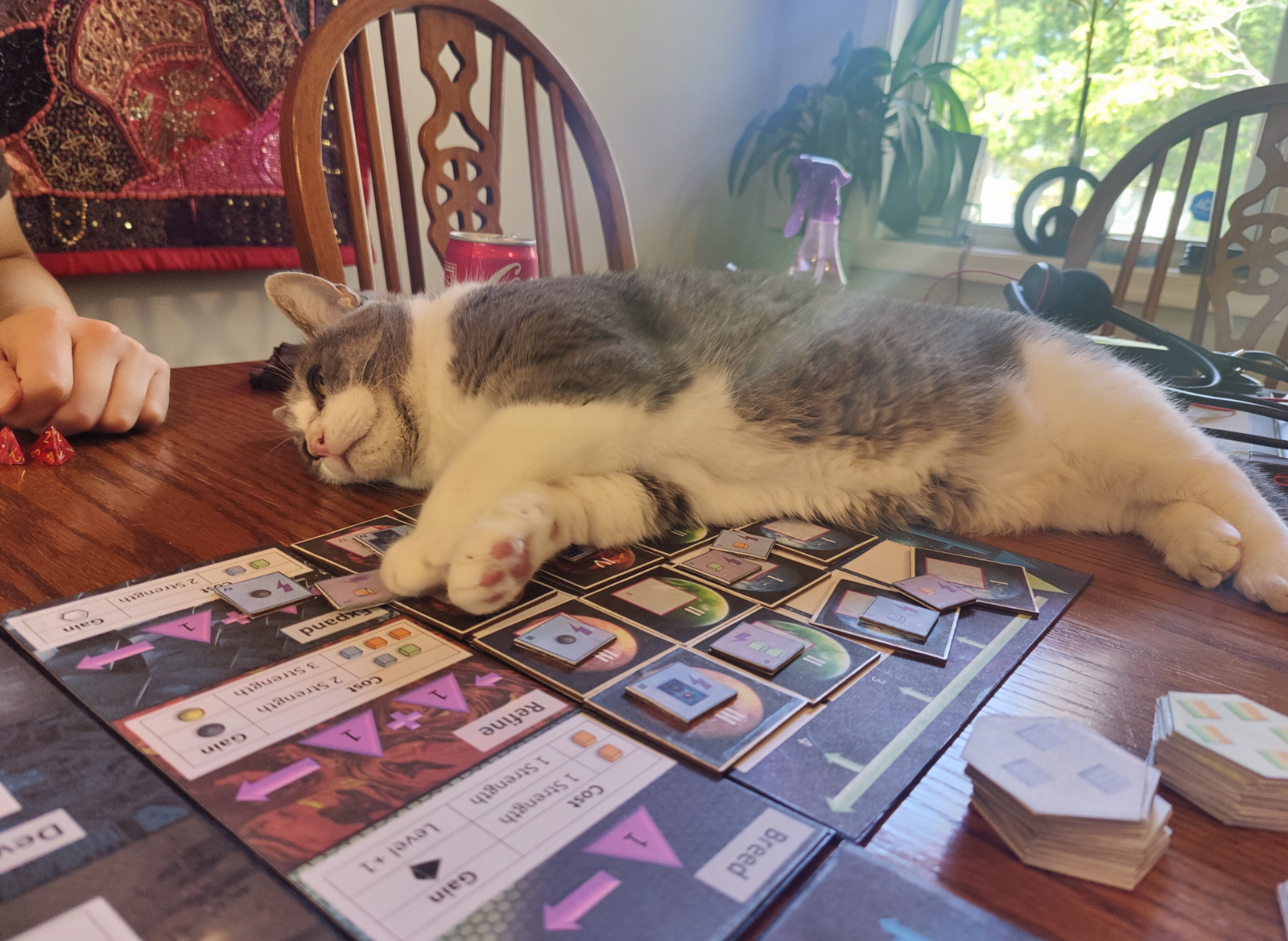
Prototype from October 2021, presented to Stonemaier for consideration. And a cat.
What games and/or game designers do you feel influenced you when making Apiary? What about them informed your work?
There are several games that directly influenced Apiary:
Charterstone/Euphoria (Jamey Stegmaier): These games use “worker bumping,” which inspired Apiary’s own bumping system. In all 3 games, spaces are never blocked. Instead, if you go to a space that is already occupied, you will “bump” the other work back to its owner. I love this bumping concept, and think it opens up a lot of interesting decisions. In a traditional worker placement game, each space can only be occupied by one worker. This often creates a tense sequencing puzzle to determine which space is most critical to go to first – but once a space is blocked, your decision has been foreclosed and the remaining options often feel lackluster. Bumping creates interesting tradeoffs: you can still go to the space, but doing so will give your opponent a benefit. Is it worth it?
Voyages of Marco Polo (Simone Luciani, Daniele Tascini): This was one of the first games I played that used dice placement. In Voyages of Marco Polo, the strength of the dice that you place determines the strength of your action. I love the depth of decisionmaking that is created by the concept of “worker strength” – instead of “place a worker on a space,” it becomes “which worker should I place here?” This simple “twist” on worker placement adds a lot of extra depth of decisionmaking, while still keeping the core rules elegant.
Glass Road (Uwe Rosenberg): Glass Road inspired the tableau-building in Apiary. In Glass Road, players are building out a tableau with three types of buildings: those that give immediate benefits, those that provide ongoing powers, and those that provide end-game scoring. Apiary uses these three types of tiles as well, and adds a 4th type of tile (farms, which provide storage and income). In addition, both games have an element of adjacency in building your tableaus, as certain tiles reward specific adjacencies.
Village (Inka and Markus Brand): Village was the first game I played that introduced the concept of “worker death.” In Village, the actions you take cost “time.” Whenever you spend a certain amount of time, one of your workers must die. In Village, you’re often trying to time your worker death correctly, so that you can get the most out of each worker while still getting that worker into a prime spot in the graveyard. Apiary has a “hibernation comb” that functions similarly to the graveyard in Village – getting to certain spaces gives you rewards, but at the cost of a worker.
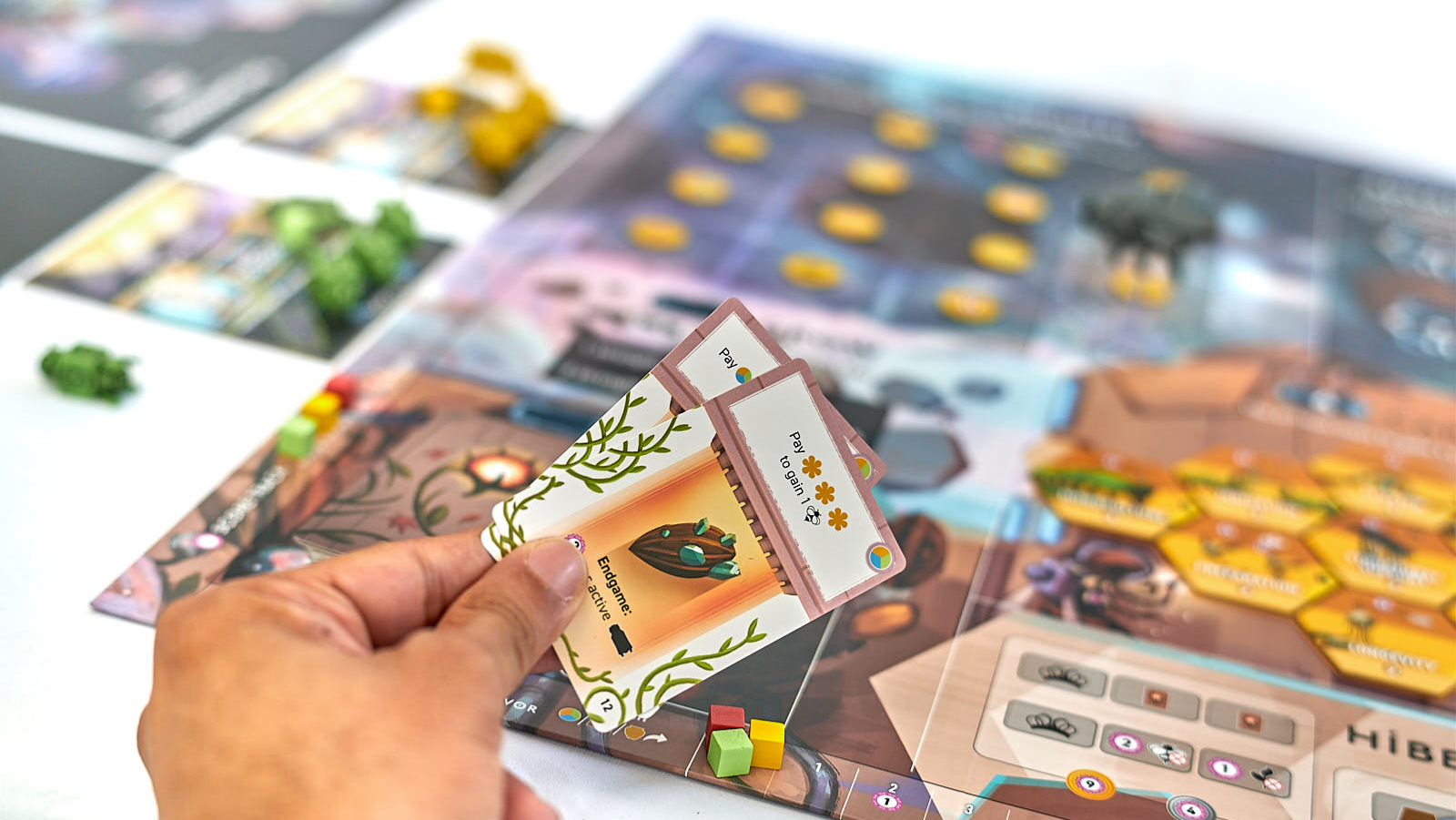
What is your position on the debate around AI generated art currently happening?
I strongly oppose using AI generated “art” in games, and am disappointed that some companies are going in that direction. In addition to creating a significantly inferior product to what can be created by talented, intelligent people, use of AI art with currently available technology amounts to theft. I’m heartened to see the backlash against AI art on social media, and hope the gaming community is able to hold the relevant companies accountable.
More generally, I’ll note that it’s unfortunate that the technology – which could be used to create, innovate, and enhance – is being used in a way that imitates and degrades its source material, and fails to identify or credit its sources. I hope that one day we can see more positive uses of what could otherwise be a powerful tool in artists’ toolboxes.
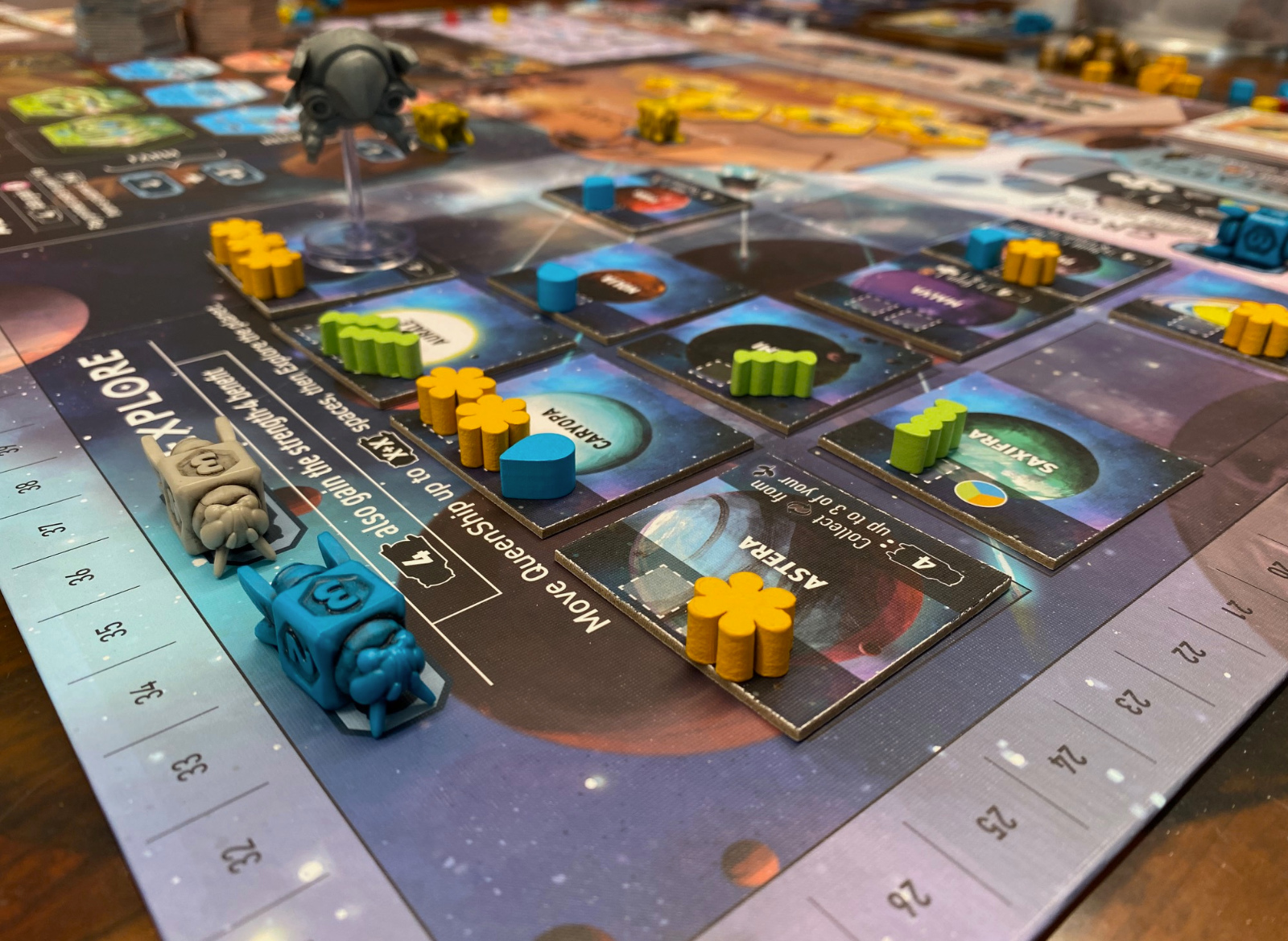
As tabletop gaming becomes more and more mainstream, we are finally seeing more diversity in players and designers alike. How has your experience been as a woman designer in an industry still largely dominated by men? What advice would you give to young women who aspire to get involved in making games?
My experience has been very positive. The board game community in Washington DC, both gamers and designers, has been extremely welcoming, and I have had a similarly positive experience in Unpub rooms throughout the country. I also want to give a big shoutout to Jamey as well – he was willing to take a chance on a first-time female designer. In working with him for almost two years, I never once felt like my input and ideas weren’t being given full and careful consideration, which has been a truly rewarding experience.
That said, I think the industry has a long way to go – as the question points out, there is still very little diversity of any type in the game design space. I do think part of this is time: for most of us, it takes time to go from a player to a designer or publisher. When I entered the board gaming hobby over a decade ago, it was decidedly more male, and more white, than it is now. I think that diversity at the ground level is necessary for diversity to begin to percolate into the design and publishing space.
That said, this increase in diversity won’t happen automatically, and it’s important for the community as a whole to keep ringing the bell to actively encourage diversity in all facets of the board game hobby. Discussions several months ago on social media that made it clear that not everyone in positions of power in the board game industry believes that women can design good games. If some people are comfortable saying that in a public forum, how many more folks have the same thoughts, but in private? It’s thoughts like this that make the release of Apiary equal parts exciting and anxiety-inducing for me. How many folks out there think that I, because of my gender, am unable to design a good game?
What I would tell an aspiring female game designer is the following: if you have the interest and the passion to design a game, then do it. Learn as much as you can about game design, but also don’t be afraid to put your own unique spin and perspective on your designs. It’s OK if your game doesn’t perfectly fit a pre-existing mold – and it may be even better if it doesn’t. Find a welcoming community of designers, either in your local community or online. Have a clear vision of what type of game you want to design, and solicit and incorporate feedback that furthers that vision. Continue the enterprise for as long as it is fulfilling and rewarding. And develop a thick skin – your game isn’t a reflection of you or of your self-worth. Your early prototypes are probably going to be bad – and that’s ok; it’s all part of the learning process. Oh, and one more thing. Once you start on this process, you’re a game designer. Not an “aspiring” game designer, just a designer.
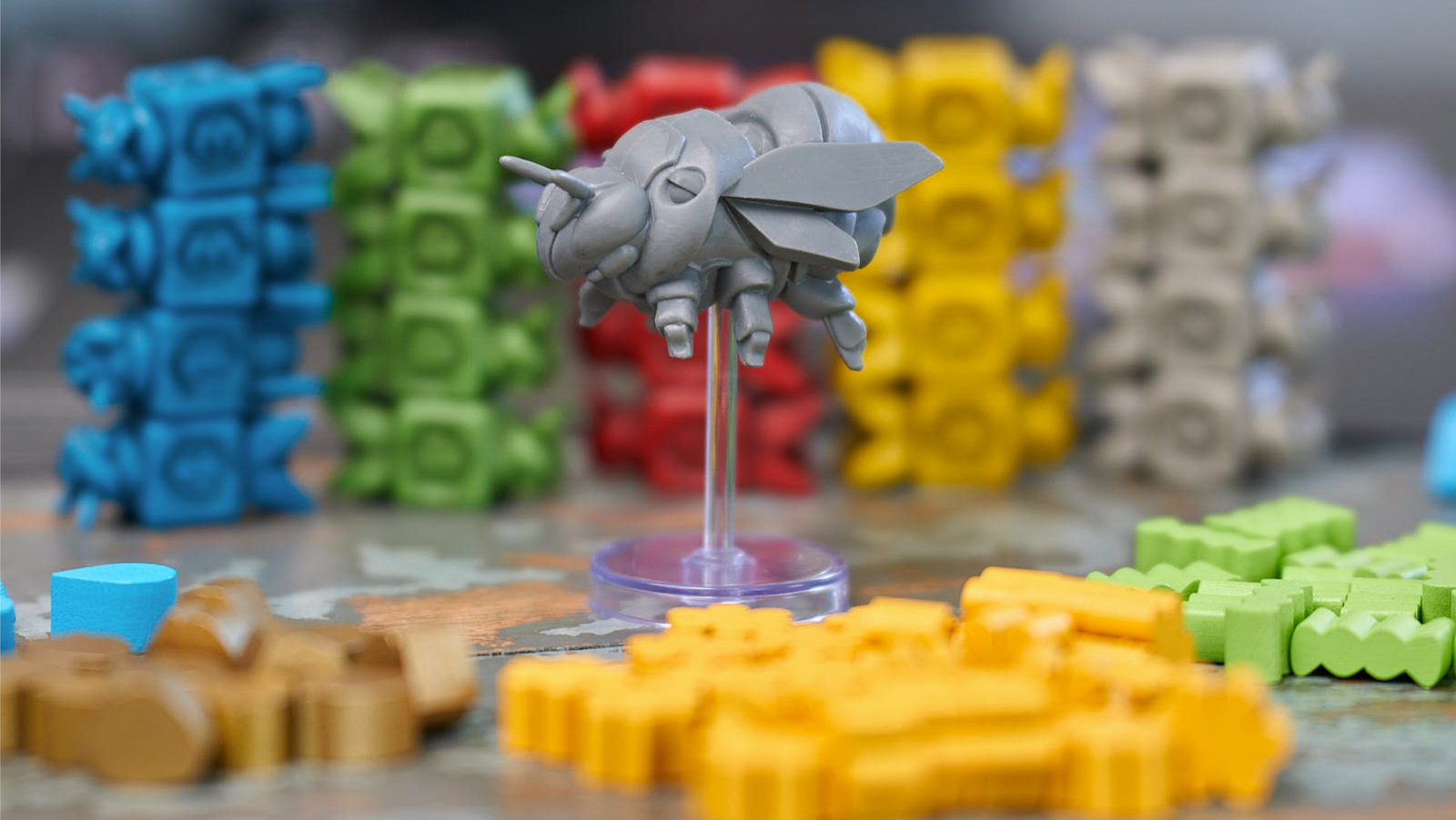
What are some of your favorite games? Why?
In addition to the games I discussed above, a few other favorites include:
The Resistance: Avalon: I have a soft spot for hidden identity games, and the Resistance: Avalon still takes the crown for me. The rules are deliciously simple (you can learn them in five minutes!), but hundreds of plays later, you can still learn new strategies and ways to play. Of all of the games I’ve played, this one has created the most memorable moments of lies, deceit, and wretched betrayal!
Five Tribes: This game has remained in my top 10 ever since it was published. The mancala method of picking up and placing meeples creates a satisfying spatial puzzle, and I love how every turn of this game is tactical, and impacts not only your position but the board state for others. It’s also one of the best balanced games I think I’ve ever played, dozens of plays in, I still don’t think one “strategy” is better than any other.
Gloomhaven/Frosthaven: In terms of “bang for your buck,” it’s hard to beat either of these games. I played almost the full campaign of Gloomhaven, and over 20 scenarios into Frosthaven. The robustness of the system continues to amaze me: each new class is a different puzzle to explore, and the variety of monsters and scenarios keeps the game feeling fresh again, and again, and again.
Decrypto: This may look like a “party” game, but it presents a set of increasingly tense decisions. The dual nature of continuing to provide misleading clues about your own words – while simultaneously trying to decode the opposing team’s words, is perpetually satisfying.
Lost Ruins of Arnak/Dune Imperium: I am 100% here for the dual worker-placement/deck-building trend, and love both of these games. They both use the same combination of core mechanisms, but feel very different. Lost Ruins of Arnak feels generous, where Dune feels unforgiving. Both, however, present interesting decisions on every turn, and the variable player powers (especially once expansions are included) keep both games feeling fresh through repeated plays.
Obviously Apiary isn’t out for a few more weeks, but we have to ask- are you cooking up any more games after this one?
I am! Unfortunately I’m not able to provide any details, but there are a couple of projects in the pipeline that I am very excited about!
For every launch notification request they get via this sign up form, Stonemaier Games will donate $1 to Pollinator.org, the Center for Native Pollinator Conservation, or Heifer International (honeybee gift). You can preorder Apiary starting October 4th, with a worldwide retail release in late November. Keep your eyes here on GamingTrend- we’ll have a review up before you know it!
